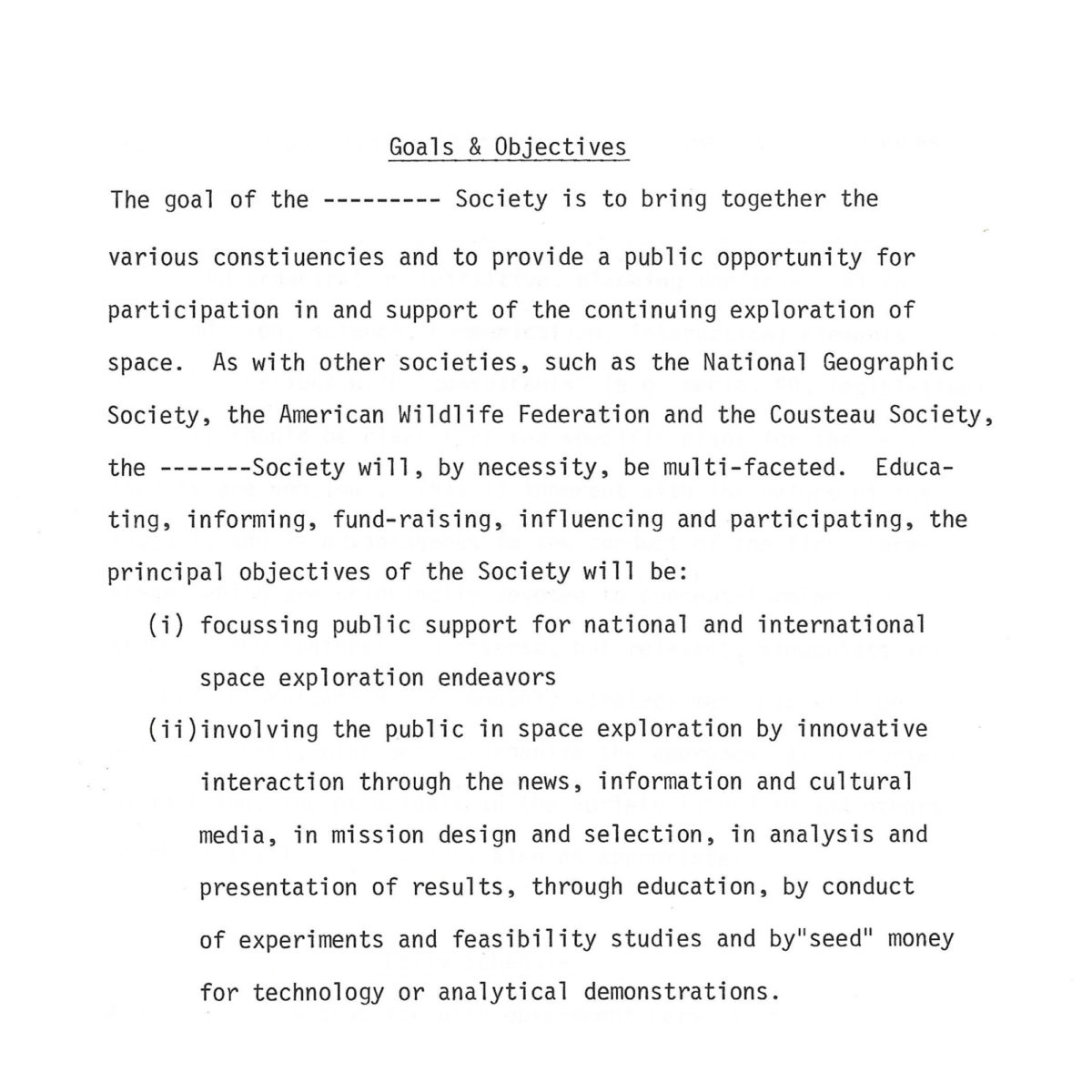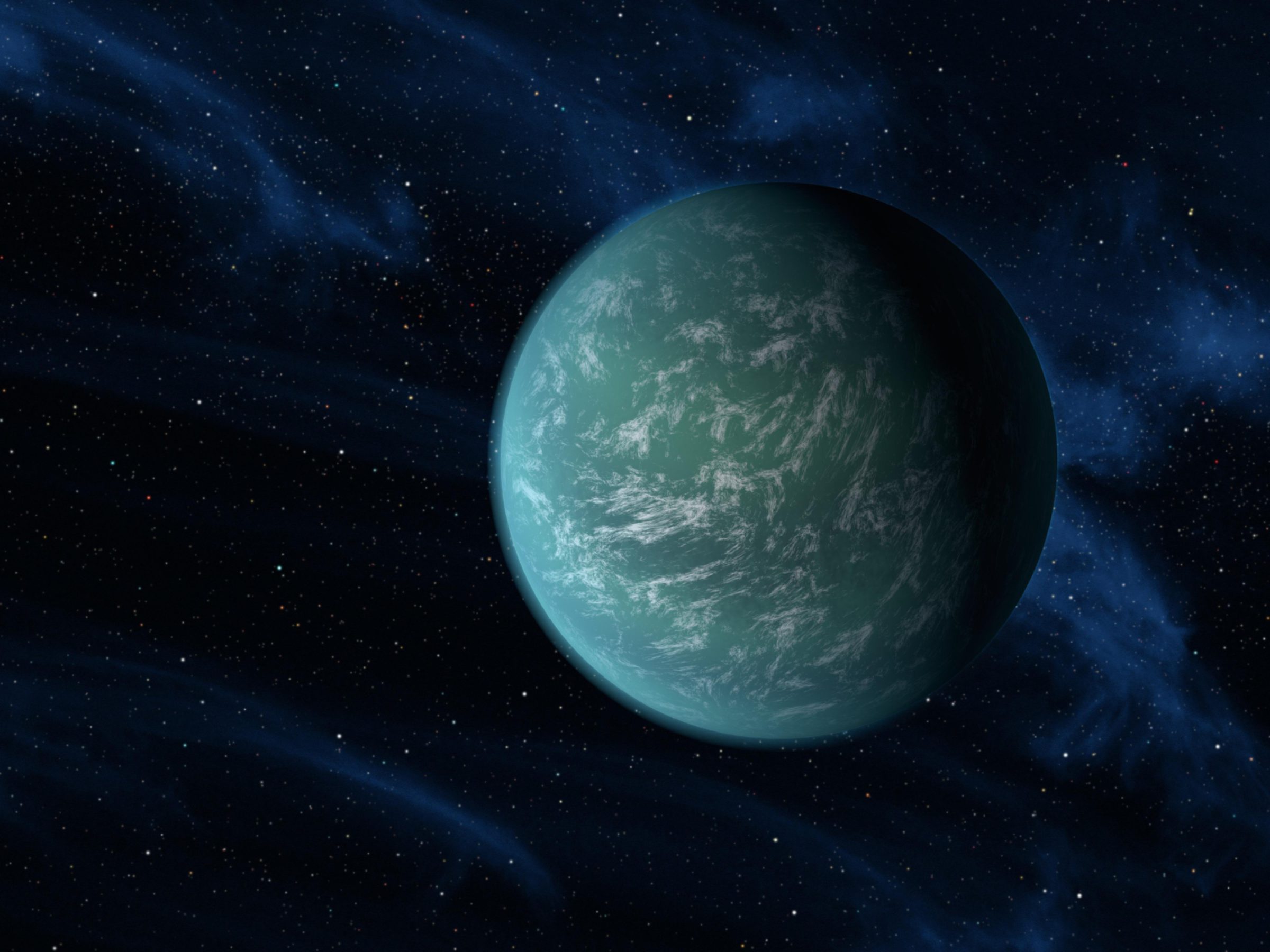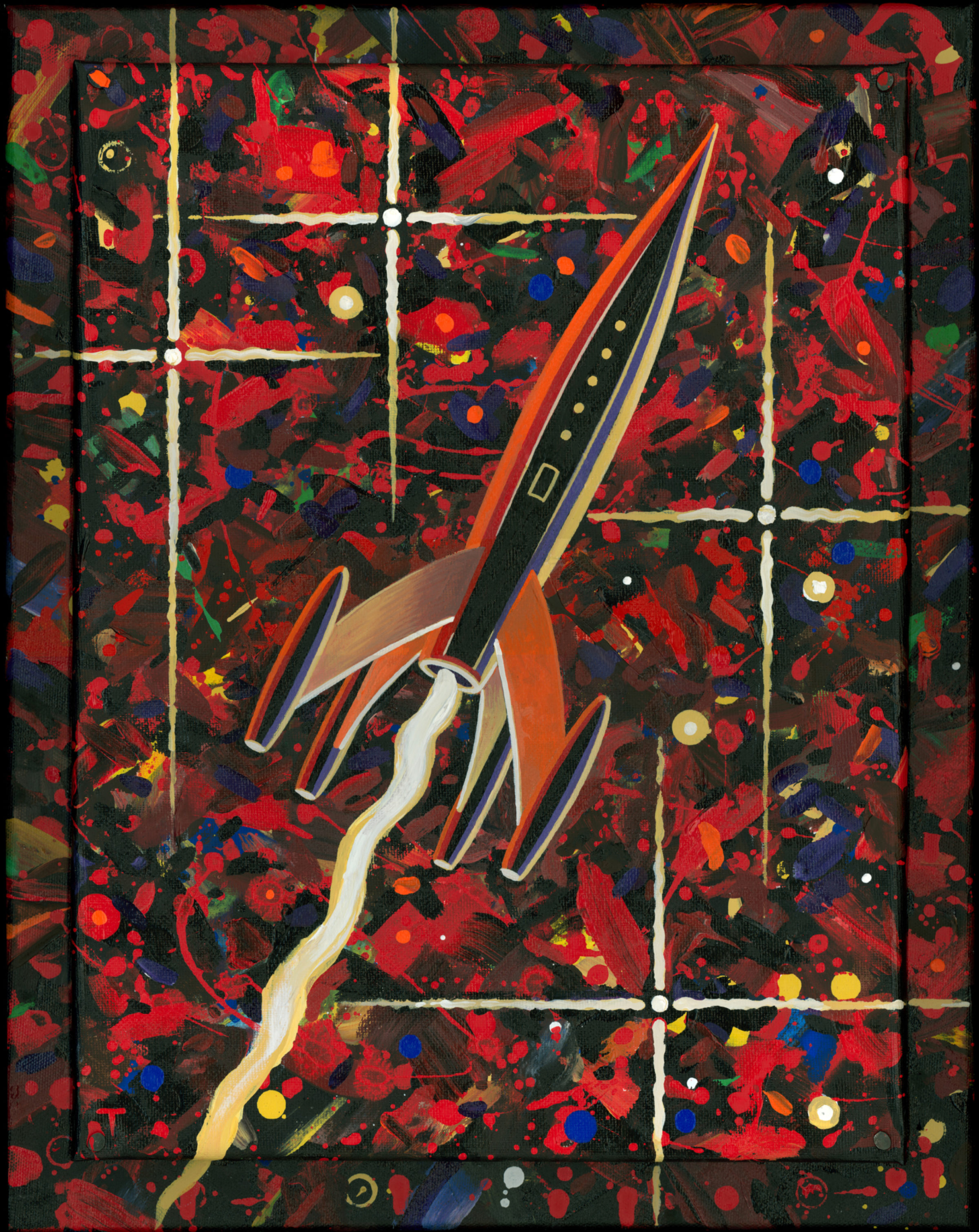
On the Cover: Voyager 1 captured this view of Europa transiting over Jupiter’s Great Red Spot on 3 March 1979. The image is composed of a 16-frames mosaic made of 41 individual images. The black spot is Io’s shadow on Jupiter’s clouds.
Download PDF
Feature Story
The Next 10 Years
Six scientists share the major planetary science discoveries of the past decade, and the questions that will drive the next 10 years of solar system exploration. Contributors: Edgard G. Rivera Valentín, Joseph G. O'Rourke, Ramses Ramirez, Maitrayee Bose, Kunio M. Sayanagi, and Brett Denevi.
Celebrating Shoemaker Grant winners, Society awards, and volunteer efforts around the world.
Space on Earth
Working Remotely: Augmented Reality Helps Far-Flung Partners

How do you build a spacecraft when your team is spread all around the country? The Europa Clipper mission, scheduled to launch in the mid 2020s, is led by NASA’s Jet Propulsion Laboratory ( JPL) in Pasadena, California in partnership with the Johns Hopkins University Applied Physics Laboratory (APL) in Laurel, Maryland. Here, team members at APL work in augmented reality (AR) to examine an immersive digital model of the Europa Clipper spacecraft’s structure. By wearing special AR headsets and using software developed at JPL called ProtoSpace, team members in different physical locations can examine the spacecraft together as if they were in the same room.
In this issue, we’re celebrating the past decade of planetary exploration and looking ahead to what the future holds. Planetary exploration at NASA is driven by the decadal survey, a community-authored report that comes out every 10 years. The past 2 decadal surveys named a Europa mission a high priority, and The Planetary Society advocated for the mission with Congress. Click here to learn more about the mission.
Snapshots from Space
Waiting for Europa Clipper

The Galileo Mission's high-resolution images of Europa revealed a stunning diversity of surface features that have fascinated and puzzled geologists. In this photo, which covers an area of about 250 by 450 kilometers (155 to 280 miles), a variety of sharp fissures and narrow linear ridges crisscross the surface where Europa’s thin ice shell cracked due to gravitational stresses from Jupiter and Ganymede. Red spots named lenticulae might identify places where material has welled up from the ocean beneath the icy crust. Europa Clipper hopes to map features like these in detail to determine where best a future landed mission might sample material that originated within Europa’s ocean.
Your Place in Space
Our Exploration Road Map
We planetary exploration enthusiasts and professionals all know that getting from one planet to another is not easy. Any mission takes years (Earth years) and millions (of dollars, euros, rubles, rupees, yen, or what have you) to pull off. We have to make careful decisions about where to go, and we have to stick to those plans until we see them through.
With this in mind, scientists who are involved in planetary exploration go through formal processes to chart the course of exploration. In the United States, this is done in what’s called the “decadal survey.” Under the auspices of the National Academies, the nation’s leading planetary scientists come together every 10 years to express their views and debate the scientific priorities for the next period of planetary exploration.
This process is widely respected among policymakers, government agencies, and the science community. NASA’s Science Mission Directorate, which initiates and oversees scientific research and missions, follows the decadal survey closely, as does The Planetary Society. Our advocacy priorities don’t come out of thin air. We support the priorities made in the decadal survey. When we engage you as a member and advocate, you support these decisions as well, and when we visit with members of the U.S. Congress and their staff, the decadal survey gives our advocacy credibility because our calls for funding are backed by an esteemed community of scientists.
When leading scientists come together to set a course and the public rallies behind them, phenomenal things happen. Among other hits, the decadal survey process gave us the Mars 2020 rover launching in mid 2020, the OSIRISREx spacecraft traveling to asteriod Bennu, the New Horizons mission to Pluto, and the upcoming Europa Clipper mission to Jupiter’s watery moon.
What's Next?
This issue of The Planetary Report gives you a sneak peek at what the scientists working on the frontier of space exploration expect for the next decade.
You’ll see how questions become hypotheses. You’ll see how ideas become missions. You’ll see how what’s desired is tempered with what’s possible right now and what will be possible with the right investments directed to the right scientists, engineers, and innovators.
As you probably know, for me personally, along with exploring distant exoplanets with ground and space-based telescopes, I hope the next decadal survey directs us to look for life here in our own solar system and beyond. I claim that such a discovery on another world would profoundly change this one.
As you peruse this issue, ask yourself: what do you want to learn about other worlds? What do you want to know next?

Celebrating 40 Years

We began as “The --------- Society.” Even before we had a name, our founders, Bruce Murray, Louis Friedman, and Carl Sagan, had a vision for an organization that would unite people in support of space exploration. Forty years later, this vision continues to be realized thanks to you. Throughout 2020, we’ll be celebrating 4 decades of empowering people like you who are passionate about discovery, exploration, and understanding our place in the cosmos. The best is yet to come. Thank you for being with us.
Get Involved
Support Exoplanet Research

Does life exist on worlds orbiting other stars? You can help us find out.
Exoplanet research—the effort to find and study planets around other stars—holds some of the greatest potential in the search for life beyond Earth. That’s why The Planetary Society is mobilizing our members to advance this fascinating field of research by supporting Yale University’s 100 Earths project.
This follow-on to other successful exoplanet projects funded by The Planetary Society aims to find 100 Earth-sized planets around nearby stars using advanced new technologies. The Society is raising funds to secure a crucial component of an instrument needed to achieve the high precision required to detect stellar movement caused by the gravity of Earth-sized planets.
Exoplanet hunting takes human intelligence, computing power, and, of course, steady funding. You can make a direct contribution to finding Earth-sized worlds beyond our solar system. Go to planetary.org/100earths to learn more.
The Downlink: Your Weekly Space Toolkit
Planetary Society members like you are committed to advancing space exploration. That’s why you fund special projects and sign petitions, and it’s why you tell other people about the exciting things happening in space.
However you choose to act, The Planetary Society is here to give you the tools you need to make an impact. This year, we launched The Downlink, a weekly email with everything you need to fuel your love of space and equip you as an advocate.
Here you’ll find the latest in space news, shareable images and factoids, ways to get more involved, and much more. Whether you’re a new space fan or a seasoned advocate, you’ll find tools in this weekly newsletter that can help you share your passion for space and take action to advance exploration.
To get this weekly newsletter, sign up for email updates at planetary.org/connect.
What's Up?
In the Sky
There is a planet party in the predawn East. Look there in late March where very bright Jupiter, bright-reddish Mars, and yellowish Saturn will all be near each other. The Moon will join them on 15 April. Then, Jupiter and Saturn will rapidly get higher in the sky as the weeks pass, with Mars climbing more slowly. Super-bright Venus will emerge low in the predawn East by late June. In the evening sky, Venus dominates the western sky after sunset until June. Bright Mercury is visible low in the evening West after sunset in late May and early June. On 21 May, Venus and Mercury will be very close together in the West after sunset but very low to the horizon. The crescent Moon will join them on 23 May. On 21 June, there will be an annular eclipse whose path crosses central Africa, Saudi Arabia, northern India, and southern China. A partial eclipse will be visible throughout most of eastern Africa, the Middle East, and southern Asia.
Random Space Fact
About 2,500 of the dwarf planet (and largest asteroid) Ceres would fit inside Earth (assuming no void space).

Trivia Contest
Our September equinox contest winner is Mercy Ocasal from Whitestone, New York, USA. Congratulations! The question was: As seen from Earth, in what year was the last transit of Mercury across the Sun (at the time the question was asked)? The answer: 2016.
Try to win a copy of V.R. Space Explorers: Titan’s Black Cat by Bruce Betts and a Planetary Radio T-shirt by answering this question:
Approximately how many of Earth’s Moon would fit inside Earth (assuming no void space, i.e., assuming the volume of Moons smooshes into the volume of Earth)?
Email your answer to [email protected] or mail your answer to The Planetary Report, 60 S. Los Robles Ave., Pasadena, CA 91101. Make sure you include the answer and your name, mailing address, and email address (if you have one). By entering this contest, you are authorizing The Planetary Report to publish your name and hometown. Submissions must be received by 1 June 2020. The winner will be chosen in a random drawing from among all the correct entries received.
For a weekly dose of “What’s Up?” complete with humor, a weekly trivia contest, and a range of significant space and science-fiction guests, listen to Planetary Radio at planetary.org/radio.
Where We Are
An At-A-Glance Spacecraft Locator

On 13 April 2020, the European Space Agency’s BepiColombo spacecraft will fly past Earth using a nudge from our planet’s gravity to drop it into the inner solar system. BepiColombo launched on a mission to Mercury in 2018. It will fly past Venus twice and Mercury 6 times before easing into Mercury orbit in 2025.
The OSIRIS-REx team selected a sampling site on asteroid Bennu in December. It is a subdued hollow filled with finegrained material, surrounded by large rocks that could present hazards to the mission. The spacecraft is now performing low flybys of the landing site, collecting high-resolution data to prepare for landing rehearsals beginning in June. The first sample attempt is currently planned for August.
Back on Earth, as many as 4 new spacecraft from 4 different space agencies are preparing to launch to Mars. All would launch as early as July 2020 and arrive at Mars in early 2021. Hope, a United Arab Emirates orbiter, is the Arab world’s first mission to another planet. It will build a complete picture of Mars’ seasonal atmospheric cycles from an orbit that is much higher than NASA’s atmospheric mission, MAVEN. NASA’s Mars 2020 rover, which appears similar to Curiosity but carries different science instruments, will search for signs of past life and collect samples for future return to Earth. The ESA-led ExoMars 2020 mission includes a rover named Rosalind Franklin that will drill for samples up to 2 meters beneath the surface, searching for signs of past and present life. Finally, China plans to launch an orbiter, lander, and rover mission tentatively called Huoxing-1 that will search for water ice, study Mars’ climate, and investigate the planet’s habitability.
For mission updates and more, check out The Downlink, our weekly email newsletter. Sign up at planetary.org/connect.
Why I Explore
The Cosmic Perspective

I don't think it'll come as much of a surprise to anyone how I became interested in space exploration. My dad was the astronomer, educator, and Planetary Society cofounder Carl Sagan. Growing up, understanding our place in the cosmos as revealed by science was a source of deep meaning and thrilling awe, something akin to spirituality. From an early age, my dad, together with my mom, writer/producer Ann Druyan, taught me the importance of knowing our coordinates in space and time—not just the city or town we happen to inhabit, not just the nation or planet, and not just the day or year but in the grandest sense we are able to grasp: our solar system, our galaxy, and our moment on the scale of the entire universe. It was a way of understanding who we are—our identity as humans and as Earthlings in the sometimesoverwhelming enormity.
Each new image from deep space is like a new revelation. Unlike a religious revelation that is perceived by just one person or a few, telescopic images of other worlds, stars, nebulae, and galaxies can be seen by everyone on Earth. We can all have these revelations together. With each one, we glean how much breathtaking beauty there is in the vastness and how much is out there that puts our own existence in perspective. The tinier we realize we are, the more vulnerable we understand ourselves to be and the more precious each and every moment is here on our little world. In this way, I feel we can begin to understand how lucky we really are to have one another, no matter our differences, on this pale blue dot.
— Sasha Sagan is a writer and the daughter of Ann Druyan and Planetary Society cofounder Carl Sagan, who together created the Cosmos television series. Her first book, For Small Creatures Such as We: Rituals for Finding Meaning in Our Unlikely World, came out in 2019. It’s part memoir about growing up with amazing parents and partially an exploration of rituals and celebrations, their histories, and how those of us who see science as the pathway to understanding might create our own. She loves to travel, another kind of exploration.
Astronomical Art
Rocket #70 by Peter Thorpe

Rockets have always been at the core of humanity’s exploration of the cosmos. Every spacecraft, every astronaut, and every experiment has relied on a rocket to reach outer space. These vehicles were initially designed as missiles and in the 1950s were adapted to launch the first satellites into orbit. Humanity’s first excursions into space, carried by powerful rockets, were infused with geopolitical conflict and competition. Over the decades, though, the exploration of space has grown far beyond its bellicose origins. With the help of rockets, we have come to understand our cosmos, our origins within it, and the fact that we are all inhabitants of the same pale blue dot. By exploring further, we may bring ourselves closer together.
Peter Thorpe is an American illustrator and astronomical artist. See more of his rocket artwork at peterthorpe.net/rockets.
The Planetary Report • March Equinox 2020
Help advance space science and exploration! Become a member of The Planetary Society and you'll receive the full PDF and print versions of The Planetary Report.


 Explore Worlds
Explore Worlds Find Life
Find Life Defend Earth
Defend Earth

